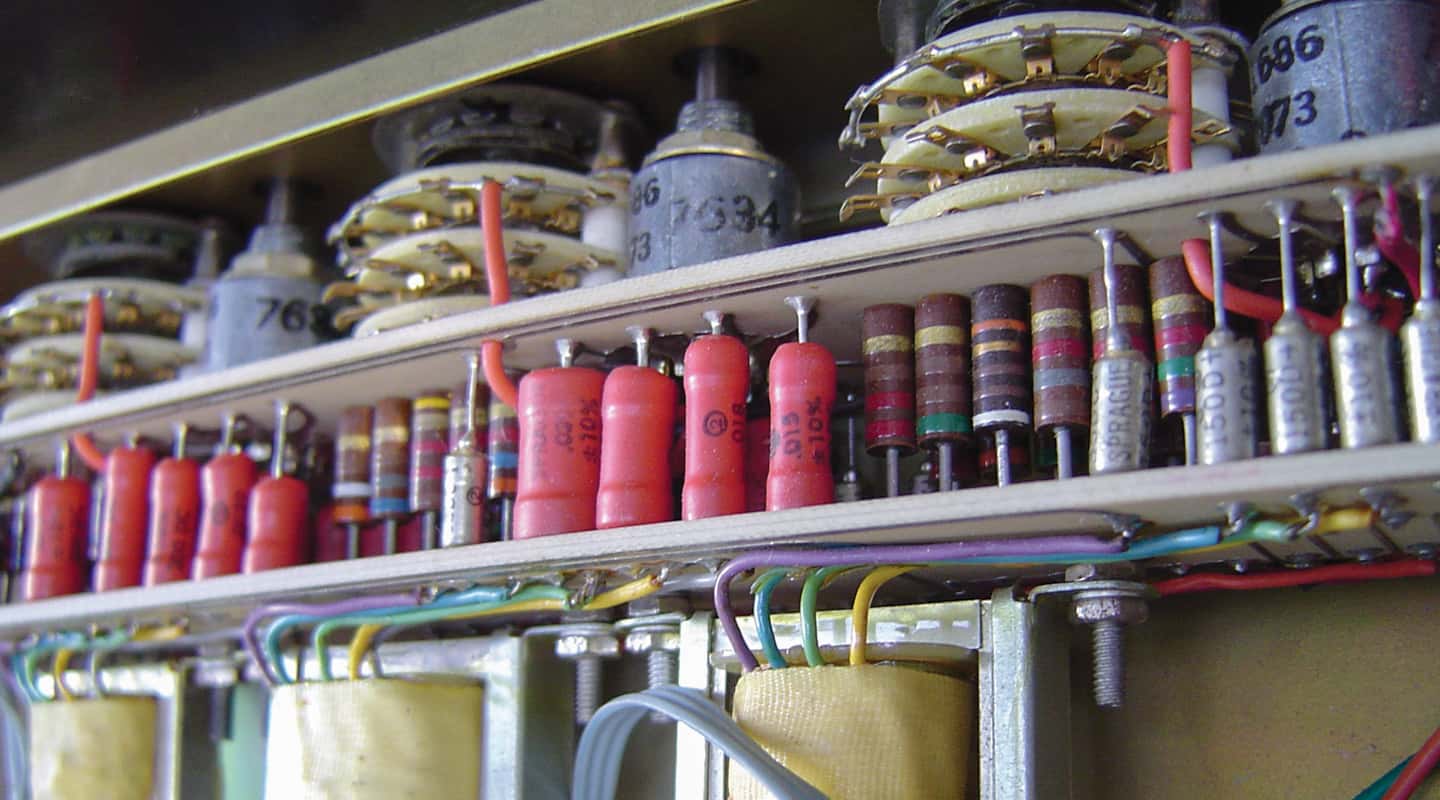
On The Bench: Equalisers
We all use them at some point, but what’s really happening underneath those fancy knobs?
Text: Rob Squire
Over the past few weeks my bench has been literally littered with equalisers of all descriptions. Some have required repair, some are in for refurbishment, while others are waiting to be born again in new custom racks. As you might expect, equalisers have been on my mind lately. It seems more than appropriate then, following on from our examination of microphones and microphone preamps in recent issues, that we now lift the lid on equalisers.
There was a time many years ago when equalisers were considered nothing more than ‘corrective devices’, usually employed to restore weaknesses in the high and/or low frequency content of recordings. These weaknesses were often the result of either the microphones used in the initial recording, the recording medium itself or the transmission of these recordings across the airwaves.
In 2008 we’re still talking about bass and treble, of course – anything below around 100Hz and above 10kHz are the generally agreed de-facto standards for defining bass and treble. But considering that the most important medium for distributing music prior to the ’60s was probably AM radio – with its inherent high frequency limitation of around 9kHz – being able to tweak frequencies in the 3 to 10kHz range was crucially important.
ENTER THE PULTEC
First built in the early ’50s and manufactured till the late ’70s, the legendary Pultec EQP-1A was the king of midrange control – still is, some say. Its design was based on a Western Electric equaliser, to which was added a tube amplifier stage. The EQP-1A is an excellent example of a very simple passive equaliser. What happens inside this device is that, after entering the unit through a balancing transformer, an input signal hits the equalisation stage consisting entirely of resistors, capacitors and inductors – all passive components – hence the label ‘passive equaliser’.
These three fundamental passive components, when combined together, have the ability to alter sound levels in a frequency dependent manner. A simple combination of a resistor and capacitor can form either a high- or low-pass filter; a resistor and an inductor can do the same. Combine a capacitor, inductor and resistor together and you’ve got yourself a band-pass filter. The EQP-1A thus achieves its boost and cut responses through combinations of these passive components. Different values of capacitors and inductors are switched into circuit by the various frequency selection switches. The resistors meanwhile are made variable through the use of potentiometers, which yield continuous variable control of boost and cut. (See Issue 53 for a detailed discussion of resistors, capacitors and inductors.)

The Joe Meek ‘Black Box’ features a bass boost band with nine selectable frequencies, a mid band with nine selectable frequencies from 1kHz to 9kHz and a top band with six selectable frequencies. It also had a ‘bass rejection’ filter, which was a high Q (sharp notch) cut control with five frequencies and a passive high and low-pass filter. Like the Pultec, this was the sort of EQ that added that ‘certain something’ to your sound even without any EQ dialed up, and when you did bring in some boost, it didn’t matter too much what you did… it just sounded better!
PASSIVE AGGRESSIVE
The downside of all this passive manipulation is that if we want to boost some frequencies but not others, the passive equaliser ‘module’ must lose some level overall first; there’s no free lunch. Think of it this way: to be able to provide, say, 10dB of boost at 100Hz, we must first design a circuit that loses 10dB across all frequencies. In other words, the whole incoming signal must lose 10dB through the passive EQ in order for our signal sporting the 10dB boost at 100Hz to be sent out of the passive EQ at 0dB. The EQP-1A passive equaliser module actually loses around 16dB in overall level and so what Pultec added to the Western Electric equaliser design was a makeup gain amplifier. This restores the 16dB of level lost in the EQ module and also provides an output that can drive 600Ω.
The Pultec’s simple use of inductors and transformers, with their inherent characteristics, combined with a high-performance low-gain tube amplifier are the things that contribute to its reputation as one of those devices where things can be made to sound better, ‘simply by running signal through it’. The apparent limitations of its control options – due to quirks in its design – mean that the bass boost and bass cut controls don’t operate at exactly the same frequencies and thus a range of EQ curves are obtained by simultaneously dialing up boost and cut.
THE TONESTACK
Other significant examples of purely passive equalisers can be found in guitar amplifiers. Most older guitar amp EQ are passive, with the exception of the ‘presence’ control (wherever amps have them). The EQ in a typical Fender or Marshall amp, for instance, consists only of capacitors, resistors and potentiometers. Yet although these amps comprise just a handful of parts (and generate much discussion amongst guitar amp nuts), there is no ‘totally flat’ setting on the controls. Indeed, on a typical Fender amp you’ll get closest to this by turning the bass almost off, the mid fully on and the treble right off! At these settings the tone control setup will lose over 20dB of overall level and yet be within 2dB of a ‘flat’ response from 20Hz to 20kHz. For those of you interested in playing with the design of guitar tone controls (even just to gain an appreciation of exactly what’s happening to the frequency response on different amps at different settings), there’s a great tool available from Duncan Amps. Visit Duncan Amps at www.duncanamps.com and locate the downloadable Tone Stack Calculator. This small application lets you select a bunch of different common amp models, change the values of the components and then ‘turn the knobs’ to see the resulting frequency response curves.
HI-FI EQ
Probably the most ubiquitous equaliser on the planet is the humble bass and treble control found on almost every hi-fi amplifier. Almost without fail, this equaliser will be based on the original design by Peter Baxandall. Indeed, to audio designers, these EQs are referred to as a Baxandall tone circuit. In 1950, Baxandall submitted his original design for his tone control to a British Sound Recording Association competition and won first prize… a wrist watch. Many years later, noting the millions of hi-fi amplifiers using his design, he no doubt wondered what a small royalty on the design might have yielded him. This design is not limited to use in hi-fi systems either. It’s also commonly found in the EQ section of many consoles.
What was unique in Baxandall’s design was the inclusion of the frequency-dependent components within the feedback path of an amplifier circuit. In this way the equalisation components became an integral part of the amplifier. This integration means that the actual gain of an amplifier is altered within frequency bands as the controls are adjusted for boost or cut. This distinction is what separates passive and active equalisers; a passive equaliser doesn’t require any amplification to fundamentally work, whereas an active EQ does. The significant aspect of this design, which sets it apart from passive designs of the time, was that it could achieve a near-flat response with the controls ‘centered’. There was no Pultec-like interaction between the bass and treble controls, where adjusting one control would affect settings of the other. In this regard, guitar amp tone controls are also highly interactive. For the world of hi-fi this achievement was hugely significant.
SAVOURY SHAPES
In essence there are two fundamental shapes or curves that equalisation achieves. Shelving filters have a ‘turnover’ frequency, a ‘corner’ frequency and a maximum range of boost or cut (see Fig. 1 below). Most passive equalisers and Baxandall equalisers have a maximum slope of around 6dB per octave, with the slope increasing as the amount of boost or cut is increased. The slope of the filter is called its ‘Q’ and the aspect of increasing Q as the amount of boost or cut is increased is, in part, what makes these filters useful. The filter effectively ‘bites’ into a narrower band of frequencies as the amount of EQ is increased relative to what would be achieved with a constant Q filter, where the slope remained constant regardless of the amount of boost or cut.
The other common filter shape is a peaking or ‘bell’ shaped curve, as typically found in mid-band equalisation. Here the filter looks like a bell (funnily enough) and contains upper and lower turnover frequencies. The closer together these two frequencies are, for a given amount of boost or cut at the peak, the sharper the shape of the filter and the higher its ‘Q’. A basic peaking filter is possible with the Baxandall design – usually fixed in frequency and Q – through the use of inductors and capacitors to embellish the basic Baxandall design and make the selection of different frequencies possible. These frequencies are selected on switches, which place differently valued capacitors and inductors into the circuit, to give the desired frequency and Q. An example of this type of EQ is found on the Neve 1073. Here, a simple treble control (no different in implementation to that found on the average hi-fi amp) and bass control are employed, with different value capacitors switched into circuit to give the range of corner frequencies. The mid-band EQ is achieved with switch-selected combinations of capacitors and inductors.
OTHER EQ TYPES
Another commonly used EQ these days is the ‘fully parametric’ equaliser. When an EQ is described as being ‘fully parametric’ this is essentially describing is that the EQ offers independent control of three parameters: decibel boost or cut, frequency and ‘Q’ (or bandwidth). Recently I was fortunate enough to have a unique EQ on the bench; a three-band EQ built for Joe Meek to his specifications in 1961. This unit could best be described as semi-parametric, just like the Pultec or the Neve 1073, in that there is variable boost and cut at different frequencies, but no variable Q. For its day, the Joe Meek (one of his ‘black boxes’ as Meek’s custom units were called) was interesting in that it used no inductors to achieve its EQ curves, just resistors and capacitors around tube amplifier circuits.
A significant aspect of these early equalisers, whether they were truly passive (such as the Pultec), or technically active (like the Neves and early Quad Eights), is that the components used for equalisation control are purely passive resistors, capacitors and/or inductors. No electronic circuits are used to create the EQ characteristics. This results in a certain sonic purity thanks to the absence of additional distortion and noise contributed by the extra circuitry.

MODERN GYRATORS
As designers began looking at different ways of achieving peaking shaped filters without using large (and expensive) inductors – in other words, when they started building less expensive EQs – one design that was exploited was what’s called the ‘gyrator circuit’. In essence, the gyrator takes resistors, capacitors and an operational amplifier, and creates an electrical equivalent of an inductor. The gyrator was invented by Bernard Tellegen in around 1948. As useable quality IC opamps came into production in the ’70s many designers exploited this circuit to produce much cheaper (and lighter) peaking elements in equalisers. However, manipulation of variable frequency was still limited to complex switch banks to put different values of capacitors into circuit to achieve different frequencies.
The fully parametric equaliser was achieved – as we read in the last issue of AT – by Burgess Macneal and George Massenburg, where the pair developed an EQ based around a unique active circuit. This circuit allowed the frequency and ‘Q’ to be continuously adjusted as well as the amount of boost or cut. This put all the EQ parameters at our fingertips, and allowed us to dial up almost any shaped filter curve we chose. A further circuit development was the ‘state variable filter’. This more complex filter element, built up from three opamps, resistors and capacitors, has the unique property of simultaneously providing a high-pass, low-pass and band-pass output. It’s also possible to continuously adjust the frequency of operation and the ‘Q’ using ganged potentiometers. Most implementations of this filter just use the band-pass section as a peaking-type filter. Examples of this design are found in the Neve 51 and V-series consoles, and are very complex. No less than 23 IC opamps are used to achieve a four-band EQ, and in this case no variable ‘Q’ has even been provided! One downside of the state variable filter is that it’s possible – at higher ‘Q’ settings – to overload some elements of the circuit below the maximum headroom point for the main audio path. This requires careful design of operating levels through the circuitry and low-noise ICs to achieve good signal-to-noise ratios.
THE 4000 ‘Q’
The EQ circuitry in an SSL4000 console is similar to that found in many consoles with simple sweepable frequency filters, but extra effort has gone into adding a variable Q control. This filter, like many of the IC-based filters, is of the same design topology as an oscillator circuit, and in the SSL, the circuit hovers just below the point at which it would become an oscillator at high ‘Q’ settings. (There is, in fact, a trim pot for each band to adjust the maximum ‘Q’ available and ensure the filter remains stable and doesn’t turn your equaliser into an oscillator! That would be bad.)
Of course, one thing to keep in mind with all analogue equalisers is that they not only turn bands of frequencies up and down, they also shift the relative phase of frequencies at the same time, with higher Q filters having larger amounts of phase shift (See Fig. 2 above). But that’s another story…
Hopefully from this overview it can be seen that there is very wide scope in the design of an equaliser. Even for two equalisers with the same front panel controls there are many ways to actually achieve those curves. May your EQ always be sweet!

















RESPONSES